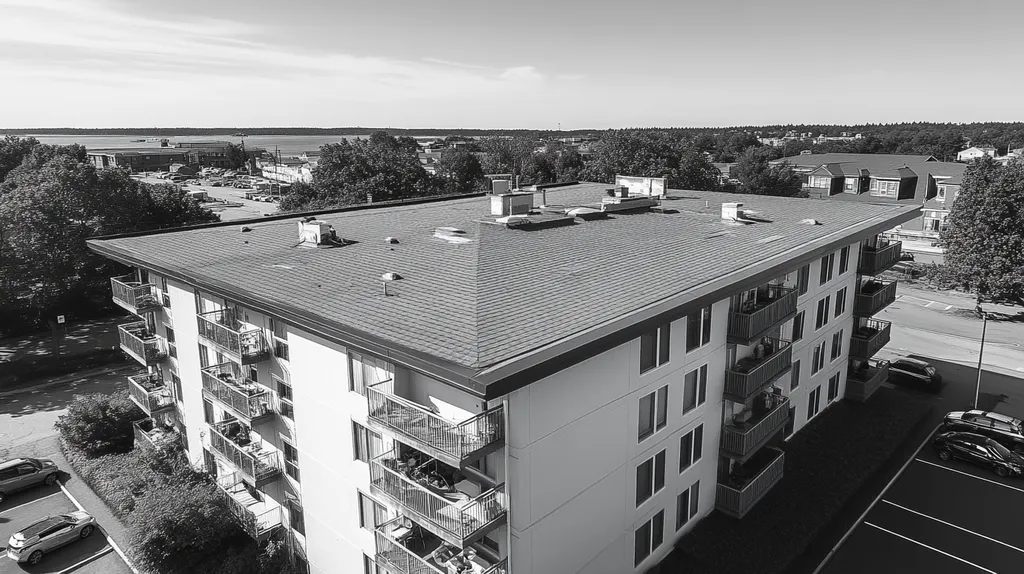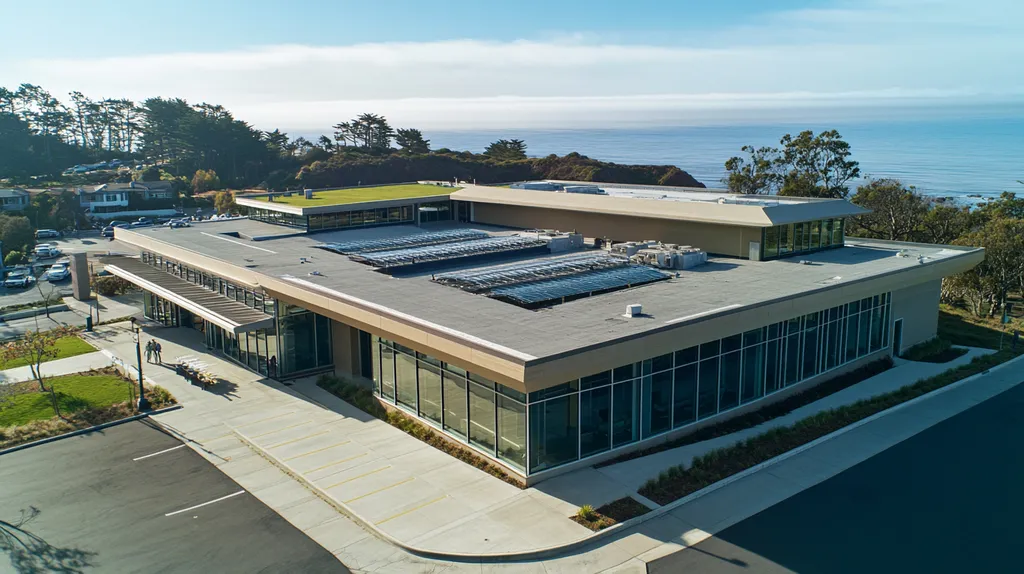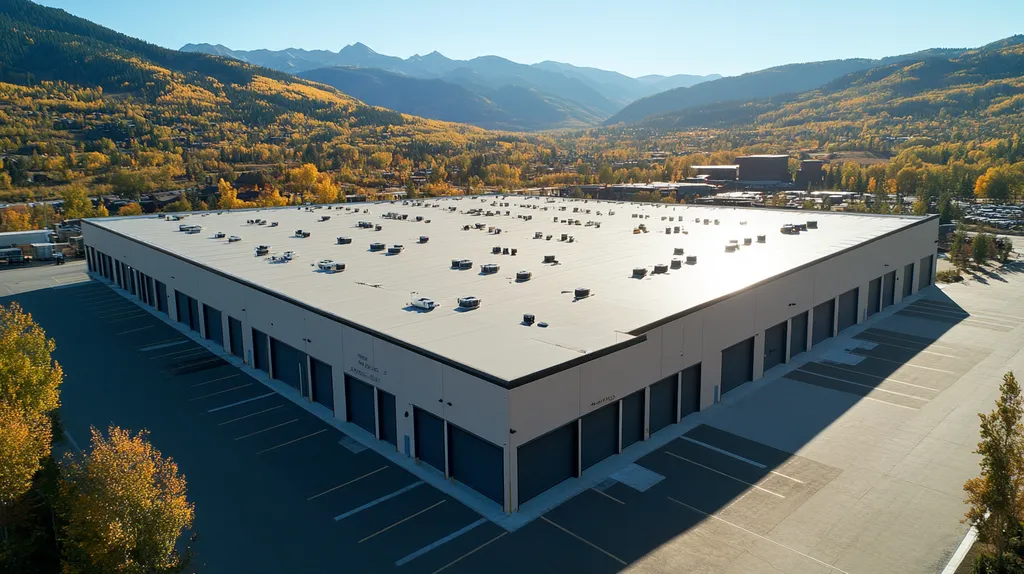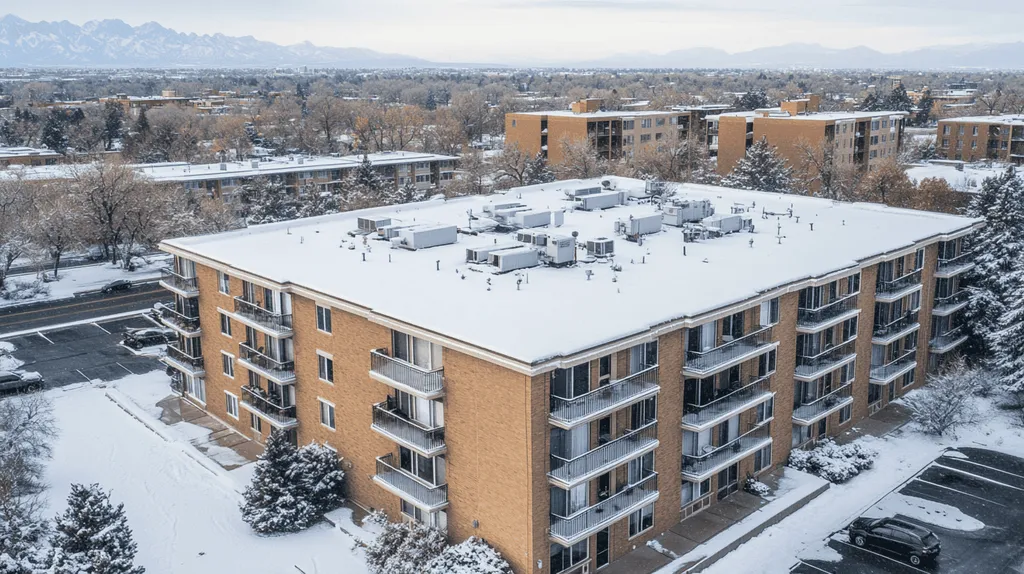The industrial roofing sector faces a critical challenge: studies show that 40% of roof coating failures stem directly from inadequate application training, resulting in billions in damage annually.
While manufacturers continue developing advanced coating technologies, traditional training methods have failed to evolve, creating a dangerous skills gap in the industry.
This comprehensive analysis examines why established training approaches are falling short, explores the systemic issues behind coating failures, and presents data-driven solutions to protect commercial property investments.
SECTION 1: CURRENT PRACTICES
The roofing industry grapples with a pressing issue: the adequacy of training programs for applying industrial roof coatings. Research shows that improper application of these coatings can lead to severe leaks and costly repairs, costing property owners thousands of dollars. Despite the high stakes, many existing training methods are outdated or poorly structured. This section delves into the prevalent training practices and their repercussions on work quality in the field.
Manufacturer-Led Training Programs
Most manufacturers offer training sessions for their products, but these initiatives often emphasize sales more than practical application. While they provide vital product knowledge, the lack of real-world context and hands-on experience proves detrimental. Contractors may find themselves ill-prepared to tackle the unpredictable conditions they face on job sites.
The gap between the controlled environment of a manufacturing facility and the actual job site can lead to misinterpretations of how materials perform under various conditions. For instance, a roof coating that appears effective in a lab might struggle under extreme UV rays or severe temperature fluctuations. This disconnect can result in significant failures, leaving property owners exposed to damage.
Additionally, depending solely on manufacturer training fosters a one-size-fits-all mentality. Different roofing types and environmental conditions necessitate unique approaches, which standard training often overlooks. This can lead to incorrect application of coatings and omit crucial project-specific steps.
The industry’s over-reliance on these traditional training methods stifles innovation. When contractors are confined to narrow training, they often overlook emerging techniques or fail to adapt to evolving industry standards. This situation calls for urgent reform to develop more comprehensive training solutions.
On-Site Apprenticeships and Mentorship
On-site apprenticeships are essential for nurturing the next generation of skilled roofing professionals. Unfortunately, many apprenticeship programs suffer from inconsistency and lack skilled mentorship. Trainees risk missing out on critical lessons that experienced veterans could offer.
In a field where hands-on experience is vital, effective on-site training is indispensable. Trainees must learn to respond to real-world challenges such as variable weather and material limitations. Encountering these scenarios during training sharpens their problem-solving abilities, yet many apprentices lack this fundamental exposure.
The disparity in mentorship quality across the industry results in inconsistent skill development. Some apprentices receive comprehensive training while others must navigate their learning without ample guidance. This imbalance can significantly affect service quality available to property owners.
Advocating for enhanced on-site educational practices is essential. By implementing standardized methods across apprenticeship programs, the industry can ensure new workers are well-equipped to meet industrial roofing demands. Effective mentorship could fortify the workforce and elevate overall standards.
Compliance with Manufacturer Guidelines
Adhering to manufacturer guidelines is crucial for extending the life of roof coatings. Yet, many contractors perceive these guidelines as mere suggestions rather than essential protocols, leading to improper applications and costly failures.
Neglecting established guidelines creates widespread repercussions. Inconsistent practices can reduce product performance, raising doubts among property owners about the reliability of their roofing systems. Erosion of trust in coating products may prompt hesitation for vital roofing investments.
Furthermore, manufacturers often lack stringent enforcement of compliance, enabling contractors to overlook critical processes. This lax oversight perpetuates poor practices, which can ultimately undermine the integrity of the roofing industry.
Emphasizing the importance of strictly adhering to manufacturer guidelines is vital for maintaining industrial roofing quality. By fostering awareness of these standards, the industry can cultivate a culture of accountability that benefits both property owners and roofing professionals alike.
SECTION 2: SYSTEMIC ISSUES
The application of industrial roof coatings is fraught with systemic issues that can jeopardize both the installation process and long-term performance. Studies indicate that improperly installed coatings can lead to premature roof failures, costing property owners millions in repairs. Addressing these issues is crucial for ensuring that roof coatings effectively fulfill their purpose. This section will dive into the inadequacies in assessing roof geometry, the impact of environmental conditions, and common pitfalls in material handling that plague coating applications.
Inadequate Assessment of Roof Geometry
A significant challenge in training for roof coatings lies in the inadequate assessment of roof geometry. Many training programs do not stress the importance of accurately measuring slopes, valleys, and drainage points. Lacking this knowledge, installers may misinterpret the roof’s architecture and apply coatings incorrectly.
For instance, roofs with complex shapes require strategic planning to ensure that coatings adhere appropriately. If installers fail to account for these design elements, issues like water pooling can develop, prompting premature deterioration. Such oversights not only reduce the effectiveness of the coating but also increase replacement costs dramatically.
Moreover, inadequate training in assessing roof geometry can result in wasted materials and inefficiency on job sites. Miscalculations can lead to delays, escalating labor costs during installation. Building owners must advocate for more robust training that includes these critical geometric assessments to protect their investments.
To enhance coating performance, it is essential that installers possess a thorough understanding of roof geometry. By amplifying training focused on this topic, the industry can reduce risks and achieve superior outcomes for all stakeholders.
Environmental Factors and Installation Timing
Environmental conditions play a vital role in the success of industrial roof coating applications. Unfortunately, many training programs tend to overlook the importance of timing installations in relation to weather. High humidity, extreme temperatures, and rainfall can significantly affect how coatings cure and bond.
For example, if a coating is applied during rainy weather, moisture may become trapped between the substrate and the coating layer. This can lead to blistering and adhesion failure, resulting in costly repairs or even complete reapplication. Property owners must ensure that installers understand these environmental factors so they can plan projects effectively.
Moreover, neglecting to account for the right installation timing can jeopardize warranty claims. Manufacturers often specify ideal conditions for application, and failure to comply can void warranties. This noncompliance puts building owners at risk for financial losses should issues arise in the future.
The roofing industry should prioritize training that includes environmental considerations. By adhering to proper scheduling and considering weather impacts, the effectiveness of roof coatings can be greatly enhanced, safeguarding both the investment and the building structure.
Material Storage and Handling Oversights
Another significant issue impacting industrial roof coating applications is improper material storage and handling. Effective training programs must encompass best practices for managing materials to prevent degradation before installation. Temperature fluctuations and exposure to sunlight can adversely affect coatings, making proper storage essential.
For instance, if coatings are stored in high heat or direct sunlight, their chemical composition can alter, diminishing performance. Installers unaware of these requirements may inadvertently use compromised materials, contributing to premature roof failures.
Additionally, improper handling during transportation can result in spills and wasted product, ultimately driving up project costs. Training that includes thorough protocols for material management is not merely advantageous; it is critical for maintaining quality throughout the installation process.
By advocating for stringent material storage practices, the industry can ensure coatings perform as intended once applied. Focusing on this aspect of installation will enhance the longevity and reliability of industrial roof coatings, yielding significant benefits for property owners.
SECTION 3: MISSED OPPORTUNITIES
The stakes surrounding proper training in industrial roof coatings cannot be overstated. Neglecting this crucial area can lead to costly mistakes and performance failures, significantly impacting both roofing longevity and overall building integrity. A recent study highlighted that improper application techniques could reduce the lifespan of coatings by an alarming 50%. For property owners and facility managers, understanding these significant gaps in current training methodologies is essential to protecting their investments.
Neglecting Proper Substrate Preparation
One of the most pressing mistakes made during industrial roof coating applications is the failure to adequately prepare the substrate. Many property owners may not realize that cleaning and priming surfaces are critical steps before applying coatings. An unprepared surface can create adhesion barriers, leading to peeling, chipping, and ultimately, early coating failures.
For instance, if debris or moisture is not properly removed, these obstacles can prevent coatings from adhering as intended. This knowledge gap indicates that many applicators are ill-equipped to assess and rectify these conditions effectively. Consequently, the lack of preparation can jeopardize both the integrity and longevity of the roofing system.
Failing to prioritize substrate preparation can have disastrous outcomes. Not only does it result in early coating failures, but it also escalates maintenance costs and disrupts daily operations. Rectifying improperly applied coatings requires substantial time, resources, and financial investment—costs that can be minimized with the right training.
Overlooking Coverage Rate and Thickness
Another significant missed opportunity in training for industrial roof coatings is the oversight of coverage rate and thickness specifications. Many applicators don’t fully grasp how vital these factors are for ensuring optimal performance and protection. Insufficient coverage can lead to uneven wear and vulnerability against harsh environmental elements.
Each coating material comes with specific coverage requirements, and failure to adhere to these standards can critically impair coating effectiveness. Many applicators may overlook the fact that variations in thickness directly correlate with the roof’s longevity and resilience, resulting in premature degradation.
The ramifications of these oversights contribute to increased maintenance costs over time and diminished overall building efficiency. Property owners may find themselves needing additional layers much sooner than expected, which can place unnecessary strain on budgets and timelines.
Lack of Ongoing Training and Support
The roofing industry is rapidly evolving, with new innovations and technologies emerging on a regular basis. Yet many training programs fail to emphasize the importance of ongoing education, leaving applicators reliant on outdated practices. This deficiency creates a workforce that is not fully equipped to implement the latest techniques and products, resulting in missed opportunities for excellence.
Regular training updates are essential for ensuring that applicators stay informed about new materials and methodologies. Facility managers should advocate for continuous training to keep pace with industry trends and capitalize on advancements that can boost roof performance.
Without adequate ongoing training and support, facility managers face significant risks. A knowledgeable workforce familiar with the latest best practices can avoid costly errors while enhancing the quality of roofing applications. Investing in continual education promotes employee performance and safeguards property investments over the long term.
SECTION 4: ROOT CAUSES
The failure of industrial roof coatings can lead to significant financial burdens for property owners and pose serious safety threats. When training programs neglect crucial aspects such as equipment selection and coating chemistry, they amplify the risk of application issues. Without addressing these fundamental root causes, the quality of roofing applications will continue to suffer, jeopardizing the longevity and integrity of facilities.
Limited Focus on Equipment Selection
One of the critical shortcomings of current training methods lies in the insufficient emphasis on equipment selection. The right tools and machinery are vital for successful coating application, yet many trainees receive minimal guidance on choosing the appropriate applicators, sprayers, or mixers tailored to specific coatings.
This oversight leads to inefficiencies and material waste. For example, utilizing an incorrect sprayer might produce uneven coverage, creating weak points on the roof that are particularly vulnerable to environmental damage. Such issues compromise long-term roof performance and escalate ongoing maintenance costs.
Moreover, operators often lack awareness regarding the influence of different equipment on finish quality. This gap in knowledge can result in safety hazards, as improperly applied coatings may increase the risk of slip-and-fall accidents in work areas.
Enhancing training programs to prioritize equipment selection will yield better application results. Facilities that invest in comprehensive training on this topic can expect improved performance and a reduction in liability risks associated with their roofing systems.
Insufficient Understanding of Coating Chemistry
Another significant concern in industrial roof coating training is the limited understanding of coating chemistry. Different coatings possess unique properties, strengths, and weaknesses dictated by their chemical compositions. Without a solid foundation in these elements, applicators struggle to make informed application decisions.
For instance, certain coatings degrade rapidly under specific environmental conditions such as UV exposure or high humidity. If technicians lack training in recognizing these characteristics, they may mistakenly apply a coating that is unsuitable, leading to premature failures and potential damage to the building.
Additionally, a deficiency in understanding how additives or blends affect longevity can result in poor material choices. By equipping technicians with knowledge in coating chemistry, they will be better positioned to select the optimal products for their roofing projects.
Fostering a deeper comprehension of coating chemistry within training programs can enhance the effectiveness of industrial roofing systems dramatically. Facilities committed to this education will likely see improved durability and performance in their roofing solutions.
Inconsistent Adherence to Best Practices
An alarming root cause of coating application failures is the inconsistent adherence to best practices. While training programs outline key procedures, they often lack the robust enforcement mechanisms required to ensure compliance across the board. This inconsistency leads to varied application outcomes, undermining roof performance.
Consider scenarios where coatings are applied either too thickly or too thinly due to the absence of standard operating procedures. Such mistakes can trap moisture beneath the surface, causing mold growth and structural damage, resulting in costly repairs for property owners. This unpredictability wreaks havoc on budgets and project timelines.
Moreover, a negligent approach to safety precautions can pose serious risks to employees. Inconsistent training practices can lead to accidents, yielding both human and financial repercussions for facilities. When best practices aren’t ingrained into the training culture, the overall quality of roof coatings diminishes.
Addressing these inconsistencies is crucial for ensuring that industrial roof coatings deliver the intended performance. Facilities that enforce strict adherence to best practices will likely enjoy greater reliability and extended longevity of their roofing systems.
DATA DRIVEN EVIDENCE
The implications of improper application of industrial roof coatings are significant and costly. Research shows that coatings applied incorrectly can fail within just a few years, in stark contrast to those installed by well-trained professionals, which can last over a decade. This section will delve into how improper application impacts the longevity of coatings, present statistical trends in coating failures, and compare case studies of success versus failure in installations.
Impact of Improper Application on Coating Longevity
Applying roof coatings incorrectly can dramatically affect their longevity and functionality. Coatings that are applied under less-than-ideal conditions, such as unfavorable temperature and humidity, suffer diminished adhesion, which often leads to premature issues like peeling and cracking. Ultimately, these failures necessitate expensive repairs or complete replacements.
Adding to this, many untrained applicators neglect vital surface preparation steps. If surfaces are not thoroughly cleaned and primed, contaminants present barriers to adhesion, threatening the entire roof system. The initial cost savings from skipping trained application can vanish quickly, resulting in hidden, long-term financial burdens.
Industry reports indicate that coatings improperly applied can fail as much as 50% sooner than those applied by skilled technicians. This sharp decrease in performance makes it clear that rigorous training is not just beneficial but essential.
In summary, the lifespan of industrial roof coatings heavily relies on the quality of application. Skilled applicators enhance product performance, ensuring financial protection for property owners by extending the roofing lifecycle.
Statistical Analysis of Coating Failures
A detailed statistical analysis reveals concerning trends in coating failures due to insufficient training. Data from various industry reports suggests that nearly 30% of all coating failures happen within the initial five years, primarily stemming from improper application techniques.
A survey targeting facility managers revealed that 42% had encountered coating failures tied to inadequate training for their roofing teams. This finding underscores a clear link between training quality and coating durability.
Such statistics indicate that embracing a data-driven approach to training could significantly improve installation success rates. With property owners increasingly pressured to maximize their return on investment, investing in proper training becomes not just advisable, but essential.
Statistical evidence paints a vivid picture: without robust training, property owners face heightened risks of costly failures, reinforcing the urgent need to reassess and upgrade existing training methods.
Case Studies of Successful vs. Failed Installations
Examining case studies highlights the stark differences between successful and failed industrial roof coating applications. A particular warehouse employing a well-trained application team achieved outstanding results, with its coatings lasting over 15 years. Routine inspections revealed minimal wear and the roof’s aesthetic appeal remained intact.
In stark contrast, a similar facility that opted for an untrained crew faced visible coating failures just three years post-application. The performance disparities vividly illustrate the importance of proper training for lasting solutions.
The cost implications drawn from these examples are equally enlightening. The warehouse with the trained crew incurred no significant repair expenses for over a decade, while the other facility faced premature replacement costs that substantially surpassed their initial investment in coatings.
These case studies powerfully demonstrate that high-quality training can lead to quantifiable differences in installation outcomes. Clearly, investing in effective training programs is crucial for guaranteeing the reliability and performance of industrial roof coatings.
SECTION 6: ALTERNATIVE SOLUTIONS
The commercial and industrial roofing industry faces an urgent need for effective training methods for applying roof coatings. Traditional training approaches struggle to keep pace with technological advancements, leading to poor application quality and costly repairs. Exploring innovative solutions is essential for boosting training effectiveness and ensuring durable roofs that meet the expectations of property owners.
Integrated Training and Certification Programs
One promising alternative lies in developing integrated training and certification programs. These programs would blend hands-on experience with theoretical knowledge tailored specifically to roofing products. By establishing standardized industry benchmarks, organizations can ensure contractors are equipped with essential skills.
These programs could incorporate online modules, virtual reality simulations, and on-site mentoring. This multi-faceted approach accommodates different learning styles, empowering applicators to apply best practices during installations.
Moreover, certification instills confidence in property owners when choosing contractors. Knowing that a contractor has completed rigorous training can provide clients with peace of mind regarding the quality of work. This assurance can lead to reduced liability and potentially lower insurance premiums for property owners.
Ultimately, integrated training can elevate industry standards, ensuring durability and performance in roof coating applications.
Advanced Equipment and Technology Adoption
Embracing advanced equipment and technology presents another compelling solution to enhance training for roof coatings. Innovations like automated sprayers and application monitoring systems can significantly improve precision and efficiency in the coating process. Ensuring contractors are trained on this new technology will lead to more consistent application results.
For instance, automated systems can promote even coating distribution, minimizing the risk of missed spots and enhancing overall performance. Incorporating technology into training also reduces human error, a leading factor in project failures.
Additionally, utilizing data analytics can yield insights into application performance post-installation. Tracking the success of applied coatings in real time allows contractors to refine their techniques and avoid common pitfalls. This data-driven approach supports continual improvement in training and application methodologies.
As the industry progresses, those who adopt advanced technology in conjunction with robust training will be better positioned to succeed.
Collaborative Manufacturer-Contractor Partnerships
Collaboration between manufacturers and contractors can foster innovative training methodologies that benefit the entire roofing community. Joint programs leverage manufacturers’ expertise while incorporating contractors’ real-world experiences. This synergy creates training content that is not only practical but also relevant to everyday challenges.
For example, manufacturers can conduct workshops to educate contractors on the intricacies of their unique products. These initiatives provide a platform for hands-on learning and troubleshooting specific challenges, ultimately enhancing contractor skill sets while building loyalty between manufacturers and contractors.
Furthermore, collaborating on training initiatives enables manufacturers to ensure their products are properly applied. Enhanced product knowledge can dramatically reduce warranty claims tied to application mistakes. By working together, both parties can protect their interests while improving the overall quality of roof coating applications.
These collaborative partnerships have the potential to elevate industry standards, ensuring better outcomes for property owners.
The Bottom Line
With 40% of roof coating failures directly attributable to inadequate training, the industry faces a critical breaking point that demands immediate action.
The evidence clearly demonstrates that traditional training approaches are failing to protect billions in commercial property investments.
By implementing integrated certification programs, embracing advanced application technologies, and fostering manufacturer-contractor partnerships, the industry can dramatically reduce the rate of coating failures.
The path forward requires abandoning outdated training methods in favor of data-driven solutions that emphasize proper substrate preparation, equipment selection, and ongoing education.
For property owners and facility managers, the message is clear: demanding properly trained and certified contractors isn’t just about quality assurance – it’s about protecting vital business assets from preventable damage.
FREQUENTLY ASKED QUESTIONS
Q. What are the current training practices for commercial roof coatings?
A. Current training often emphasizes product knowledge over practical application, leading to unprepared contractors. Many programs fail to provide hands-on experience essential to tackle real-world challenges. This gap results in improper installations, which can cause leaks and significant repair costs for property owners.
Q. How does inadequate assessment of roof geometry impact industrial roof applications?
A. Inadequate assessments can lead to misapplications, resulting in issues such as water pooling. If installers do not measure slopes and drainage points accurately, they risk premature deterioration of the roof. This oversight can dramatically increase repair costs and reduce coating effectiveness.
Q. What are the consequences of neglecting proper substrate preparation on commercial roofs?
A. Failing to prepare substrates can lead to peeling and early coating failures. Without proper cleaning and priming, adhesion barriers form, jeopardizing the roofing system’s integrity. This oversight not only increases maintenance costs but can disrupt business operations due to repairs needed.
Q. How does limited focus on equipment selection affect industrial roof coatings?
A. Insufficient emphasis on selecting the right equipment can lead to inefficient applications. Using incorrect tools can produce uneven coverage, weakening your roof’s durability. Furthermore, it can create safety hazards, increasing the likelihood of accidents in work areas.
Q. What statistical trends highlight the importance of training for industrial roof coatings?
A. Statistical analysis reveals nearly 30% of coating failures stem from poor training techniques. A survey reported that 42% of facility managers faced issues directly related to inadequate training, emphasizing the urgent need for improved methods. Investing in proper training is therefore essential for enhancing coating durability.
Q. What are some innovative alternatives for training in applying roof coatings?
A. Innovative alternatives include integrated training programs that combine hands-on experience with theoretical knowledge. Utilizing virtual reality and online modules can cater to different learning styles. Establishing manufacturer-contractor partnerships for collaborative training can enhance practical skills and awareness of product applications.
Q. How can ongoing training and support improve industrial roof application quality?
A. Ongoing training ensures contractors remain informed about the latest materials and application techniques. Regular updates boost their skills, enabling them to avoid costly errors. By investing in continuous education, facility managers can enhance application quality and protect their asset investments effectively.











